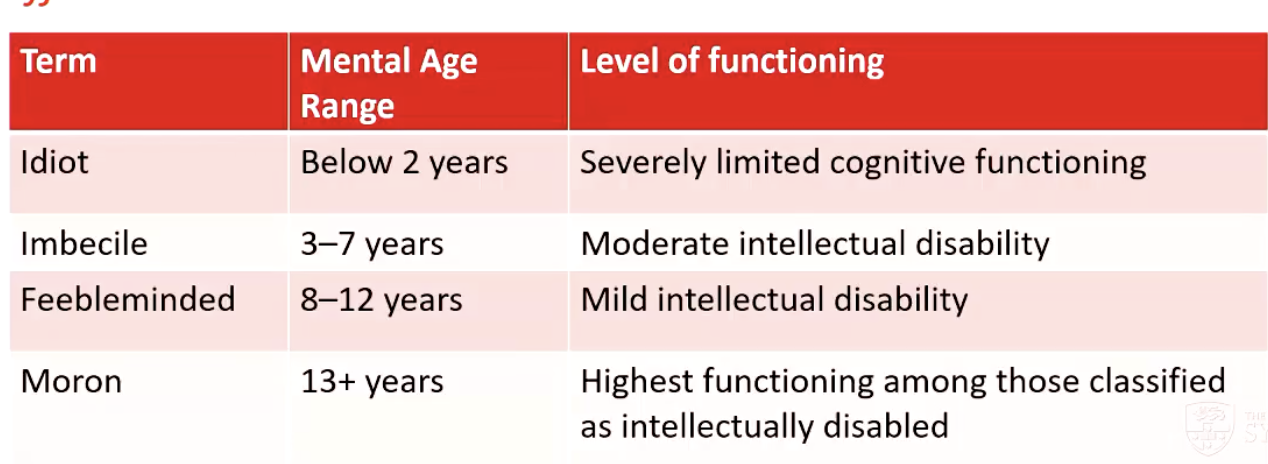MA Lecture 2 - Origins of Intelligence Testing
1/19
There's no tags or description
Looks like no tags are added yet.
Name | Mastery | Learn | Test | Matching | Spaced |
|---|
No study sessions yet.
20 Terms
Historical Context
late 19th to early 20th century France
growing concern abt children struggling in school
French govt sought method to identify students needing special ed support
Alfred Binet (1857-1911)
commissioned in 1904 by the French Ministry of Edu
collaborated w Theodore Simon to develop practical tests for schools
Developement of the Binet-Simon Scale (1905) — Standardisation
1st standardised test to measure mental abilities in children
standardised — administered & scored in a consistent manner
uniform —everyone takes the same test under similar conditions
objective scoring — answers scored using consistent method
comparability — results can be compared across indv, groups or time periods
Developement of the Binet-Simon Scale (1905) — Overview
Test focused on identification, memory, reasoning
30 diff tests increasing in difficulty
verbal knowledge of food, objects, body parts
memory tests
resemblance (e.g. how are a fly, ant, butterfly and flea alike)
explaining abstract terms (diff between weariness and sadness)
Developement of the Binet-Simon Scale (1905) — Key Principles
Aim: identify students who needed extra support in school (“slight” intellectual disability)
scores are practical not theoretical
only assesses performance
not designed to assess causes
not designed to label people
test developed further to establish age norms
Revised test (1908) — Age level tests
introduced age level grouping for age based comparison
conducted extensive testing of children across various ages & ability levels
developed graded intellectual tasks — increasing cognitive complexity
standardised age assignment — task assigned to specific age level if at least 75% of children at that age could successfully complete it — ‘typical’ age performance
Revised test (1908) — What did they need for each age
Age 3 — identify body parts, repeat simple sentences, describe pictures
Age 5 — compare weights, copy shapes, count coins
Age 7 — complete unfinished pictures, count fingers, copy images
Age 9 — know the date, define familiar objects
Age 12 — repeat complex figures, create rhymes, solve abstract problems
Age 13 — describe abstract figures, explain differences btwn abstract terms
Mental Age and Task Difficulty
Age level of the most difficult task a child can successfully complete
e.g. — if 5 year old can solve tasks designed for 7 year old but not beyond then their mental age is 7
Binet’s Position
incremental theory
intelligence not fixed and can develop over time
can be developed through education
not a single ability
Binet’s Legacy
test laid the foundation for modern intelligence testing
influenced educational psychology, cognitive assessment & developmental research
compassionate attitude — focus on present abilities not labels
his values were not universal
Francis Galton
19th century British polymath
cousin of Charles Darwin
pioneer in psychology, statistics & human measurement
introduced key statistical & research methods
correlations, regression
1st look at twin studies to examine nature and nurture
proposed lexical hypothesis
Galton & Intelligence
entity theorist (fixed biological trait)
intelligence was something hereditary
influenced by Darwin’s theory of evolution
indv differences and natural selection
founder of eugenics
advocated for selective breeding to improve human intelligence
believed that intelligence was related to sensory discrimination
visual acuity, auditory accuracy, tactile discrimination, reaction time
James McKeen Cattell
‘mental tests’
sensory tests didn’t predict academic performance
Lewis Terman
Eugenicist
also believed intelligence was largely inherited and stable
Advocated for:
identifying & supporting the ‘gifted’
restricting reproduction among those deemed ‘feebleminded’
his work contributed to standardised testing and tracking systems in schools
Test Evolution — Standford-Binet
Terman
revised and published Binet’s test
become the standard against which others were validated
Henry Goddard
Eugenicist
applied intelligence tests to immigrants arriving at Ellis Island
believed low intelligence was hereditary — linked to crime and poverty
forced sterilisations
advocated for:
restricted immigration based on intelligence
sterilisation & institutionalisation of those w low intelligence
used culturally biased tests in english
Historical Classification of Intellectual Disabillity
Early 20th century class

Mixed Legacy of Intelligence Testing — Negatives
contributed to racist & xenophobic immigration policies
reinforced social hierarchies based on race, class & percieved intelligence
helped legitimise eugenics as public policy in education, healthcare and law
misused to track minority & indigenous peoples into lower educational streams
Mixed Legacy of Intelligence Testing — Positives
educational personalisation
clinical assessment
early identification & support
development of aptitude tests
cross-cultural research into cultural fairness & universality of cognitive constructs
contributed to test-taking culture
Contributions to Policy — E Morris Miller
influenced Tasmanian legislation on ‘mental deficiency’
Tasmanian Mental Deficiency Act (1920)
Responsibility & care for intellectually disabled
Lovell (1923) — NSW had no provision for intellectually disabled